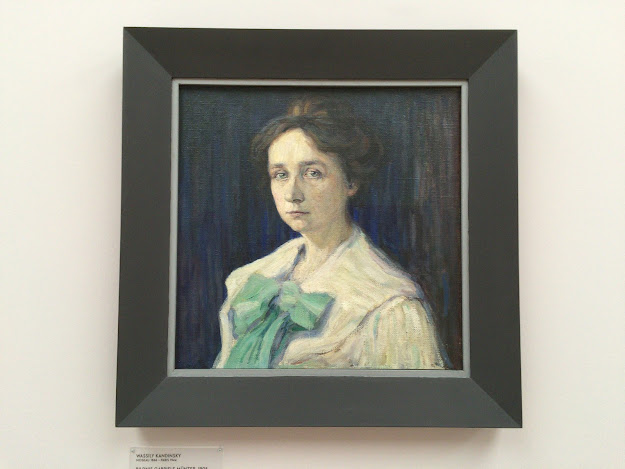フランツ・マルクは1880年2月8日にミュンヘンで貴族の流れをくむ名家に生まれた。
19歳の時に、兵役のキャンプで馬に乗った時、動物が持っている自然の世界における純粋さに触れて、動物を描く画家になりたいと強く思ったという。
Franz Marc was born on February 8, 1880, in Munich, to a noble family.
When he was 19 years old, when he rode a horse in a military camp, he wanted to become a painter of animals by touching the pureness of animals in the natural world.
When he was 19 years old, when he rode a horse in a military camp, he wanted to become a painter of animals by touching the pureness of animals in the natural world.
マルクは、その後、カンディンスキーらと出会い、青騎士の活動に参加する。
1912年にパリを訪れてロベール・ドローネーに会ったり、キュビズムや未来派などにも影響を受けた。
マルクの作品を見ると、そうした影響が見て取れる。
Marc then meets with Kandinsky and participates in the activity of Blue Knight.
In 1912 he visited Paris to meet Robert Delaunay and was influenced by cubism and futurism.
When you look at Marc's work, you can see such influences.
In 1912 he visited Paris to meet Robert Delaunay and was influenced by cubism and futurism.
When you look at Marc's work, you can see such influences.

マルクは第1次世界大戦に従軍して、1916年のヴェルダンの戦いで命を落としてしまう。36歳の若さだった。
Marc died in World War I and died in the Battle of Verdun in 1916. He was 36 years old.
アウグスト・マッケは、1887年1月3日にドイツのメシュデで生まれた。
マルケに出会い親しくなり、青騎士の活動にも参加した。
1914年にはマルケを通じて知り合ったクレーらとともにチュニジアを訪れている。
August Macke was born on January 3, 1887 in Meschde, Germany.
He met Marke and became familiar with him, and also participated in the activities of Blue Knight.
In 1914 he visited Tunisia with Klee and others he met through Marche.
He met Marke and became familiar with him, and also participated in the activities of Blue Knight.
In 1914 he visited Tunisia with Klee and others he met through Marche.
マッケもマルケ同様に、第1次世界対戦が始まると従軍した。1914年にシャンパーニュの地で戦死。27年の充実しながらも短い人生だった。
一緒にチュニジアを旅行したパウル・クレーは、その旅行から多くものを自らの作品に活かしている。
果たして、マッケの人生がもう少し長いものだったら、どんな新たな作品をこの世に送り出していたのだろうか。
Macke, like Marke, also served when World War I began. In 1914 he died in Champagne. It was a fulfilling but short life for 27 years.
Paul Klee, who traveled with him in Tunisia, put a lot of work from his trip into his work.
If Macke's life was a little longer, what kind of new work would he bring to the world?
Paul Klee, who traveled with him in Tunisia, put a lot of work from his trip into his work.
If Macke's life was a little longer, what kind of new work would he bring to the world?
ガブリエレ・ミュンターは、1877年2月19日にベルリンで生まれた。
父親はアメリカで成功した商人だったが、若い頃は1848年革命にも参加したという自由な思想の持ち主だった。
Gabriele Munter was born in Berlin on February 19, 1877.
His father was a successful merchant in the United States, but when he was young, he had the free thought that he had participated in the 1848 Revolution.
His father was a successful merchant in the United States, but when he was young, he had the free thought that he had participated in the 1848 Revolution.

ミュンターはその後、絵を学ぶためにミュンヘンに行ったが、そこでカンディンスキーと出会い、恋に落ちた。
ミュンターの作品には、カンディンスキーと自分を描いた作品がおおい。ミュンターにとっては、カンディンスキーは絵の先生でもあったが、それ以上に彼女の人生にはなくてはならない存在だった。
Munter then went to Munich to study painting, where he met Kandinsky and fell in love.
Many of Munter's works include Kandinsky and himself. For Munter, Kandinsky was a painting teacher, but more than that, an integral part of her life.
Many of Munter's works include Kandinsky and himself. For Munter, Kandinsky was a painting teacher, but more than that, an integral part of her life.
カンディンスキーは、ロシアで革命が起こるとロシアに戻ってしまった。
ミュンターは、ずっとカンディンスキーを待ち続けていたが、カンディンスキー は別な女性と結婚して、ミュンターの元に戻ることはなかった。
カンディンスキーが描いたミュンターの肖像画が展示されていた。
ナチスが政権を握ると、前衛芸術は激しい弾圧を受けた。
その作品を所持すること自体が危険な行動だったが、ミュンターは80点以上のカンディンスキーの作品や他の青騎士の画家たちの作品を生涯にわたり守り続けた。
1957年、80歳になったミュンターはその膨大なクレクションをすべてミュンヘン市に寄贈した。
今日、カンディンスキー、マルク、マッケ、クレー、そしてミュンターらの作品をレンバッハギャラリーで見ることができるのは、間違いなく、彼女のおかげなのだ。
The portrait of Munter by Kandinsky was on display.
When the Nazis came to power, avant-garde art was severely suppressed.
Although possessing the work was a dangerous act in its own right, Munter continued to protect more than 80 Kandinsky's works and other Blue Knight painters' works throughout his life.
In 1957, Munter, who turned 80, donated all of his enormous collection to the city of Munich.
It's definitely thanks to her that the works of Kandinsky, Marc, Macke, Klee, and Munter can be seen today in the Lenbach gallery.
When the Nazis came to power, avant-garde art was severely suppressed.
Although possessing the work was a dangerous act in its own right, Munter continued to protect more than 80 Kandinsky's works and other Blue Knight painters' works throughout his life.
In 1957, Munter, who turned 80, donated all of his enormous collection to the city of Munich.
It's definitely thanks to her that the works of Kandinsky, Marc, Macke, Klee, and Munter can be seen today in the Lenbach gallery.
(Translated by Google Translate)







コメント
コメントを投稿